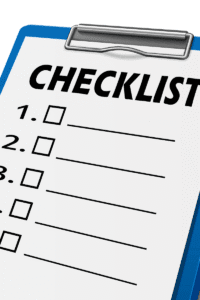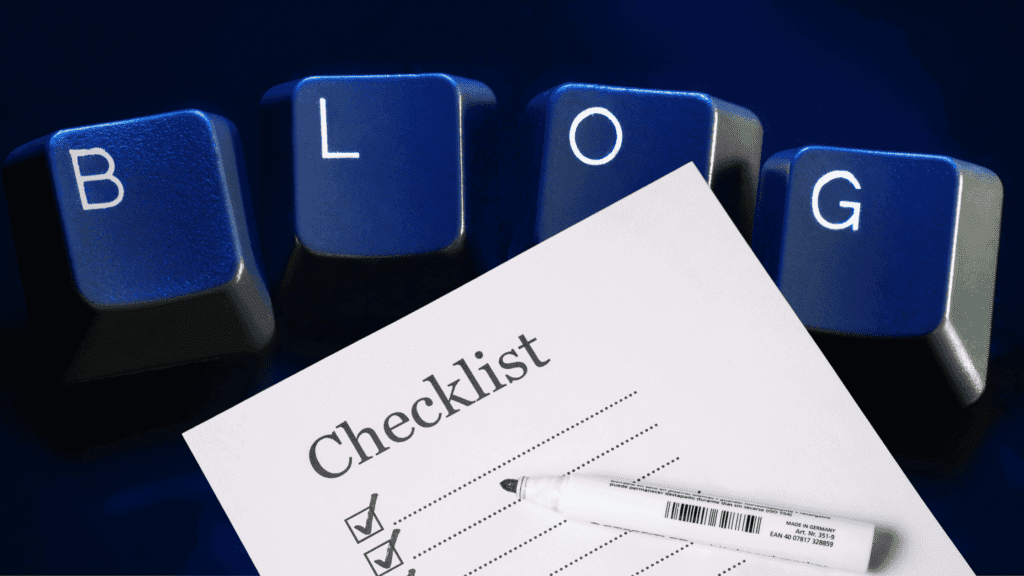Everyone is quick to advise new writers to “just start a blog.” However, jumping in without a plan always results in burnout. To avoid failure on your first try, you need a blogging checklist. In other words, a guide with simple but detailed instructions on what needs to be done in order of priority.
Setting up a blog and publishing consistently involves more work than most beginners expect. Skipping even a small detail, whether it’s picking a niche or optimizing content, can disrupt your goals. Consider a checklist your compass for intentional blog building.
How well you follow the direction in this blog post will determine whether you struggle or thrive seamlessly in your blogging career.
Best blogging checklist beginners can use for free

We’ll begin from the very scratch and walk all the way to the top. A little advice: You may want to pick up your pen and jotter to write them out.
Define your blog idea and target audience
We all have a reason for wanting a blog of our own. So, what’s yours? What value are you hoping to offer? It’s okay if nothing comes to mind this minute.
Here’s how to come up with blog ideas: create a list of random ideas you’re interested in and can confidently talk about. From here, you can choose a profitable niche, such as finance, tech, education, or health and wellness. In blogging, niching down gives you focus so you won’t talk about irrelevant topics.
In addition, it allows you to target a specific audience and understand their pain points, age, location, and interests. For instance, writers want to learn to write better, and students want blogs on scholarship listings. I am writing this post to provide blogging tips for beginners, as newbie writers are part of my audience.
After this, you want to analyze high-ranking blogs in your niche, what they write, and how they structure their content using SEO tools like SimilarWeb and SEMrush.
Focus on providing content that answers questions your competitors left unanswered. If they only discuss the importance of content creation, you should provide readers with unique ideas for content creation.
Choose the best blogging platform for your goals
Your blogging platform affects your scalability, security, and SEO performance, so it’s okay to be picky. After testing a few platforms based on cost, ease of use, customization, and features, here’s my conclusion:
Squarespace: Sleek and secure. Perfect for design-focused blogs, but expensive.
Wix: Quite popular with customizable features, but less flexible, and offers limited SEO features.
Blogger: Google’s platform. Free, but may not offer the best professional features. You can use it for testing ideas or hobby projects.
WordPress.org: Search-engine friendly, with a wide range of plugins and free themes. This one gives you total control of your blog. Take the advice of an experienced blogger: If you’re a beginner, WordPress is the most flexible platform for monetization and long-term growth.
It offers more features to support SEO optimization via plugins such as Yoast and RankMath. But if simplicity and speed are your major concerns, Wix and Squarespace may be better options.
Set up the essentials in the blogging checklist
We’ve crossed the bridge of deciding on the platform for your blogging journey. Now is the time to tick off the blog setup essentials before you publish posts.
Domain name
A domain name is the address of your blog on the Internet. You need to get this part right because your domain name gives your blog an identity and allows users to find you. Decide how you want your domain name to end. A .com domain name helps your blog reach beyond your region and attract a worldwide audience.
A domain that ends with your country code (.ng, .uk, .au, .ca, etc.) will limit your reach to your country alone. A .org domain is more for organizations, while a .gov domain is for the government or its affiliates.
As someone ready to start blogging for money, it is more profitable to choose a .com domain. However, if you wish to target just your region, then use the .region domain. This will cost you about $8 or more, depending on what you want.
Moving forward, you can buy and register your preferred domain name on Domain.com. If you also wish to purchase from hosting platforms, go ahead and do that. Try Namecheap, GoDaddy, Hostinger, Bluehost, etc.
Web hosting
Web hosting, simply put, is your personal rented space on the internet that will house your blog. You need one that is fast and reliable if you must experience seamless blogging. Basic hosting plans cost between $3 to $10 per month.
Again, hear this: before opting for cheap hosts, understand that your blogging career is as good as your web host. Everything from your blog’s speed, uptime, and overall health depends on it.
Check out WPX, Hostinger, Namecheap, and Bluehost, which are perfect for beginners. Remember when we talked about a domain name? Web hosting platforms offer both hosting and domain names, so you don’t have to buy them separately if you don’t want to. Moreso, confirm that they attach an SSL certificate to your site for security.
Theme
On our blogging checklist is the blog theme. Themes are collections of templates used to manage or control a blog’s layout. Your selected theme determines the overall appearance of your blog (colors, features, fonts, structure, responsiveness, etc).
WordPress comes with many free themes, so you can choose the one that works best for you and your blog. Once you purchase your domain name and hosting, and connect them to WordPress (I assume you will go for WordPress because it is the best), you can upgrade from the default theme and customize your blog to suit your style and passion. Themes like Kadence, Blocksy, OceanWP, and Grace themes are free and aesthetically pleasing.
Meanwhile, there are premium themes with free versions you can start with and upgrade whenever you’re ready. Examples: Astra, Inspiro, OceanWP, Sydney, Vantage, GeneratePress, etc. Settle for something easy, interesting, and, most importantly, responsive.
Core pages
When you’re done setting up your blog’s theme, the next step is to set up the important pages:
The homepage: Here is the entry point to your blog. It is where people land mostly when they come to your blog. The home page also displays your latest blog posts. Therefore, ensure it is user-friendly and will help visitors navigate your site.
The about page: This page serves as a little window, giving visitors a glimpse of who they are reading from. Use this page to briefly introduce yourself and anything else you wish people to know.
Privacy policy page: It serves as a legal page that explains how data is collected on your blog. You can write yours or get help from the internet and modify it to suit your blog’s activities.
Contact us page: This page lets your audience reach you. It could be for a collaboration, a complaint, or anything that needs your attention.
Blog post section: Your blog posts appear right on your home page. If your niche requires you to blog about two or three different topics, you must break them into categories. For example, a lifestyle niche blogger may decide to share content on home decor, gardening, and recipes. Instead of packing everything into a single post and making a mess of your blog, you can create a category for each topic and post accordingly.
Plugins
Plugins are add-on tools that extend your blog’s features. They make blogging easier, but can also slow it down if you are not careful. Downloading and activating too many plugins on your blog will surely slow it down. That is why you have to be mindful and use plugins that are absolutely necessary.
WordPress offers a wide variety of free plugins that serve different purposes. Therefore, as a new blogger, you can install the following plugins:
WP Super Cache – Regularly clears your blog’s cache, improving page load speed.
Backuply – Backs up your posts and keeps them safe and secure.
Jetpack – Protects your blog from spam and hackers and also provides analytics.
SEO plugin – Helps you implement SEO best practices on your blog. You can go for Yoast, RankMath, AIOSEO, Sufer SEO, etc.
Google Analytics and Google Search Console
These are crucial blogging tools that help you analyze all the activities going on with your blog. They provide information to help you manage traffic.
While Google Analytics tracks what users do inside your website, Google Search Console tracks your website’s performance on Google search.
SEO blogging checklist
Unless you’re creating a private blog, prioritizing search engine optimization is essential. Proper SEO ensures Google will trust, crawl, and index your page. Think of it as a foundation you must lay for a thriving blog. Here are a few compulsory steps:
Activate your SSL certificate: Remember the SSL certificate that comes with your web hosting? Now’s the time to set it up. It’s not only mandatory for ranking purposes but also boosts your site’s security and credibility.
Use clean permalink structures: It’s difficult to attain SEO results with the default permalink structure. Ensure yours has no dates, fillers, or numbers. For WordPress, go to Settings → Permalinks → choose “post name.”
After writing a blog post, right before you hit ‘publish’, ensure that your post’s permalink or URL is in line with the blog post topic, too.
Submit your sitemap to Google Search Console: Sitemaps list the URLs of the pages on your blog. Exposing your sitemap to Google is one excellent SEO move. It lets Google know about all the pages you wish the bots to crawl and rank.
Copy your Sitemap URL, go to your Search Console, paste your sitemap URL, and submit to the ‘URL Inspection’ box right at the top of the interface. This helps Google notice and crawl your page for ranking. Alternatively, you can submit each post’s URL to the ‘URL Inspection’ box and ask Google to index your post.
Use a mobile-friendly theme: Ensure your page is mobile responsive. Test on smaller screens to ensure the layout is clear and the text is unbroken.
Read more about the SEO checklist to become in tune with what must be done.
Blogging checklist for creating writing content
If you’ve been following and implementing, congratulations, your blog is ready, and your niche is set. Now it’s time for the real work: creating content. Writing your first blog post demands all the intentionality you can muster.
This is because the first set of blog posts you will publish will lay the foundation of your blogging experience and decide if Google will take you seriously. To ensure your success, you must start with keyword research.
Conduct keyword research
Through keyword research, you will identify specific words and phrases to rank for. Free tools such as Google, Google Trends, Ubersuggest, Answer the Public, and People Also Ask can help you identify relevant keywords.
With this, you can write content that answers search queries. Instead of targeting highly competitive keywords, go for words with low difficulty and higher volume.
Follow SEO best practices
Any post you publish should have at least a solid 80% on your blog’s SEO plugin to meet Google standards. If you want to rank, don’t focus on keyword research without considering other on-page optimization strategies. Over the years, I have learned to go through this checklist before publishing a new post.
To begin with:
- Put your main keyword where it matters the most and naturally in your body text.
- Add relevant images and never omit alt texts.
- Prioritize high-quality internal and external links.
- Pass the 300-word mark.
- Provide expert information and cite credible sources.
Have a content plan
Your blogging checklist should always include a content strategy. This is because consistent posting is the key to profitable blogging. That said, map out topics, brainstorm ideas, and create outlines so you always have content ready.
Should you run out of topics to write, explore trending topics in your niche and answer relevant questions your audience may have. Here is a post that can guide you on how to create a blog content plan.
Follow a simple structure for every post
Sometimes you don’t need to overcomplicate things on your blog. Maintain a simple structure: your title should be the only one in the H1 tag.
Introduce your topic with a subtle CTA that invites readers to read further for more details. Keep your introduction catchy, or readers won’t bother with the next section.
Avoid unending texts. Use paragraphs, subheadings, and bullet points to improve your content’s readability.
Blogging checklist on building a brand
Branding is among the most critical steps in blogging. Remember, yours is not the only blog on Google. So you need to be clear about what you represent.
Personalizing your blog name, writing style, tone, and voice makes you more memorable. Make sure even the littlest details, down to your color scheme, are unique.
From here, you can build a community of returning readers and develop a reputation that stands out in the crowded industry.
Market your blog
After publishing your first post, it’s possible to draw in traffic from outside Google. Start by opening pages for your blog on social media platforms like Facebook, Instagram, and X. You can also promote on TikTok, Pinterest, or build your email list.
Go wherever your target audience hangs out. Stay active, join conversations, and drop relevant blog links. This way, you can gain traffic without ads.
Collaborating with influencers can also spread the word faster. Connect with popular pages online. You can either pay them or kindly ask them to share your blog links on their page. From there, you can amplify your reach.
Last but not least, focus on link building to boost your rankings. However, you only get backlinks or people citing, sharing, or saving your page when you solve actual problems. In simpler terms, you must first give value to earn backlinks.
Repurpose content
Every social platform has its own rhythm and content style. Rather than copying and pasting your blog post everywhere, extract valuable information and rewrite it to meet each platform’s expectations. This process is known as content repurposing.
For example, I can turn this entire article into a carousel post or turn key points from this post into a Twitter-worthy thread.
Through this approach, I save time and attract more readers to the main source – my blog.
Track the blog’s growth
This is where Google Analytics becomes your best ally. Make it a point to monitor your progress on the site. Check top-performing posts on your page and use that insight to create supporting cluster posts.
For instance, if a blog post performs well in SERPs, I can come back to write about another closely related topic.
In addition, keep track of page views, dwell time, engagement, and search queries. Refresh low-ranking posts with better keywords. At the end of any post, ask for feedback from readers. Interacting with your audience helps you serve them better. In the end, only people-first content sits on Google’s first page.
There you have it: all the information you need to launch a successful blog today.
Now, the final truth: this blogging checklist is not exclusive to beginners. Even as an expert, there’ll be days when you need a template to reduce your workload. When that moment comes, feel free to return to this post for the ultimate blogging cheat sheet. Or at best, bookmark this post now.


